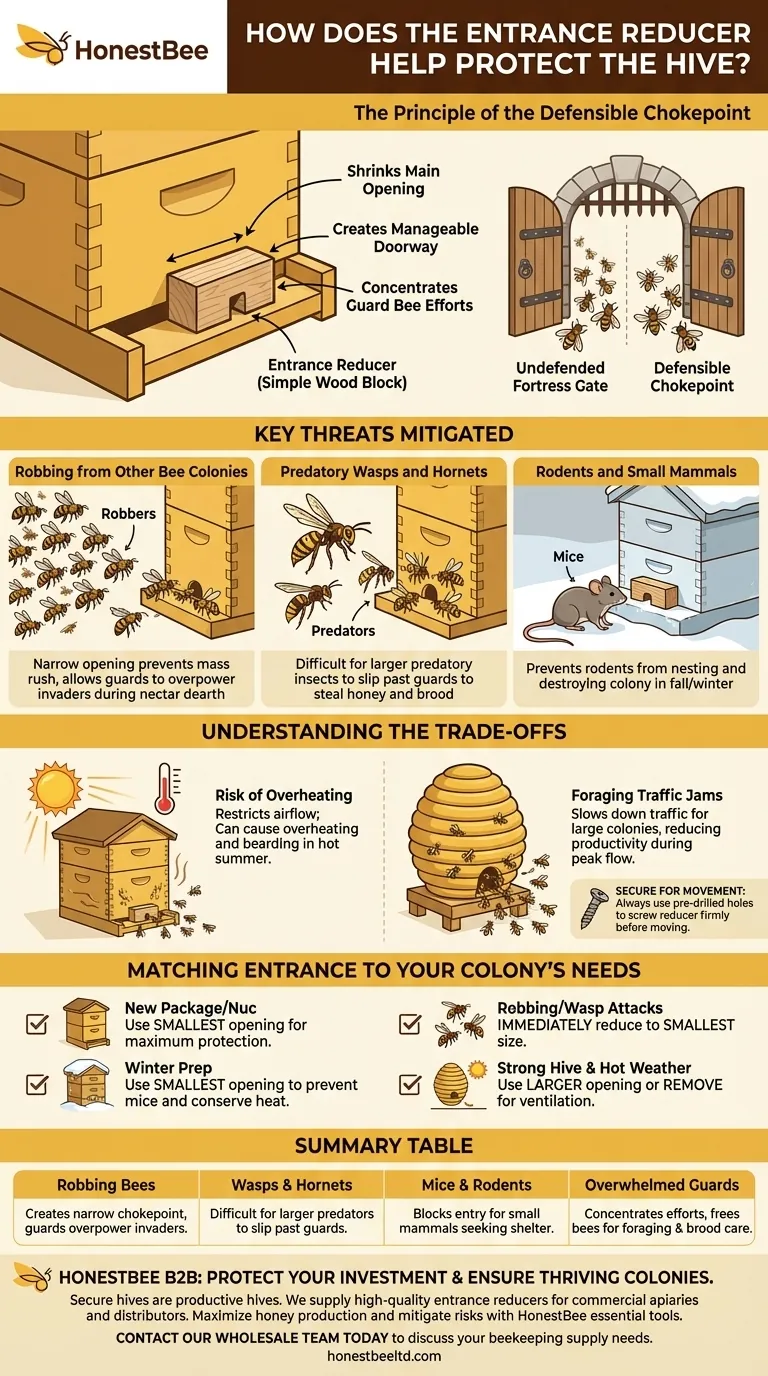At its core, an entrance reducer is a simple block of wood that shrinks the main opening of a beehive. Its function is straightforward: to create a smaller, more manageable doorway. This allows the colony's guard bees to more effectively monitor and control all traffic, providing critical protection against a variety of external threats.
The primary value of an entrance reducer is not just physical obstruction, but the creation of a defensible chokepoint. This simple change empowers a colony's natural defenses, allowing a small number of guards to protect the entire hive, especially when it is small, young, or otherwise vulnerable.

The Principle of the Defensible Chokepoint
A large, open hive entrance is like an undefended fortress gate. By narrowing that entrance, you fundamentally change the defensive equation in favor of the colony.
Concentrating Guard Bee Efforts
A smaller entrance requires fewer guard bees to monitor it effectively. This frees up more of the colony's workforce for other essential tasks like foraging, nursing brood, and producing honey.
Overwhelming Invaders
A narrow opening forces invaders—be they robbing bees or predatory wasps—to enter one by one. This prevents a mass rush and allows the waiting guard bees to easily overpower and dispatch threats as they appear.
Key Threats an Entrance Reducer Mitigates
The protection offered by a reducer is not theoretical. It defends against specific, common dangers that can weaken or destroy a colony.
Robbing from Other Bee Colonies
During a nectar dearth (a period with few flowering plants), strong honey bee colonies may try to rob weaker ones. An entrance reducer is the single most effective tool to stop this, as it makes it nearly impossible for robbers to overwhelm the hive's defenses.
Predatory Wasps and Hornets
Wasps, yellow jackets, and hornets are persistent predators that try to enter hives to steal honey and brood. A reduced entrance makes it much more difficult for these larger insects to slip past the guards.
Rodents and Small Mammals
During the fall and winter, mice and other small rodents seek warm, sheltered places to nest. A beehive is an ideal target, but a mouse cannot fit through the small opening of a properly installed entrance reducer, which protects the colony from destruction over winter.
Understanding the Trade-offs
While essential, using an entrance reducer involves balancing security with the colony's operational needs. Using the wrong size opening at the wrong time can cause problems.
Risk of Overheating
A small entrance significantly restricts airflow. During hot summer days or a strong nectar flow, this poor ventilation can lead to the hive overheating and the bees "bearding" on the outside of the hive.
Foraging Traffic Jams
For a large, booming colony, a small entrance can become a bottleneck. It slows down the traffic of foragers coming and going, which can reduce the colony's overall productivity during a peak nectar flow.
Securing the Reducer for Hive Movement
If you need to move a hive, the entrance reducer is critical for containing the bees. However, it can be jarred loose during transport. Always use the pre-drilled holes to screw it firmly to the bottom board before moving.
Matching the Entrance to Your Colony's Needs
The decision to use a reducer, and which size opening to use, should be based on the colony's strength and the time of year.
- If you are installing a new package or nuc: Use the smallest opening to give the small, developing colony maximum protection as it gets established.
- If your hive is preparing for winter: Use the smallest opening to prevent mice from entering and to help the bees conserve heat.
- If you observe robbing or wasp attacks: Immediately reduce the entrance to the smallest possible size to help the colony defend itself.
- If your hive is strong and the weather is hot: Use a larger opening or remove the reducer entirely to improve ventilation and prevent foraging traffic jams.
By actively managing your entrance reducer, you are tuning your hive's security and efficiency to meet its changing needs throughout the year.
Summary Table:
| Threat | How the Entrance Reducer Helps |
|---|---|
| Robbing Bees | Creates a narrow chokepoint, allowing guards to overpower invaders one by one. |
| Wasps & Hornets | Makes it difficult for larger predatory insects to slip past the hive's guards. |
| Mice & Rodents | Blocks entry to small mammals seeking shelter, especially in winter. |
| Overwhelmed Guards | Concentrates defensive efforts, freeing more bees for foraging and brood care. |
Protect your investment and ensure your colonies thrive.
At HONESTBEE, we understand that a secure hive is a productive hive. Our high-quality entrance reducers are designed for commercial apiaries and distributors who demand durable, effective equipment for managing large-scale operations.
We supply the essential tools—like entrance reducers, frames, and protective gear—that help beekeepers like you mitigate risks and maximize honey production.
Contact our wholesale team today to discuss your beekeeping supply needs and learn how our products can strengthen your apiary's defenses season after season.
Visual Guide

Related Products
- HONESTBEE Professional Multi-Functional Hive Tool with Ergonomic Wood Handle
- Multi-Function Plier-Style Frame Grip Hive Tool
- Professional Dual-End Stainless Steel Hive Tool for Beekeeping
- HONESTBEE Professional Long Handled Hive Tool with Precision Cutting Blade
- Professional Stainless Steel Pry-Bar Hive Tool
People Also Ask
- What safety precautions are advised for beekeeping with hive tools? Master Safe Handling for Calm, Efficient Hives
- What is the hole in a hive tool for? A Multi-Tool for Apiary Repairs and Maintenance
- What types of hive tools are available for beekeepers? Choose the Right Lever for Your Apiary
- What is a multifunction scraper hive tool? The All-in-One Solution for Efficient Beekeeping
- What are the features of a J-hook hive tool? Effortlessly Lift Frames with Superior Leverage



















